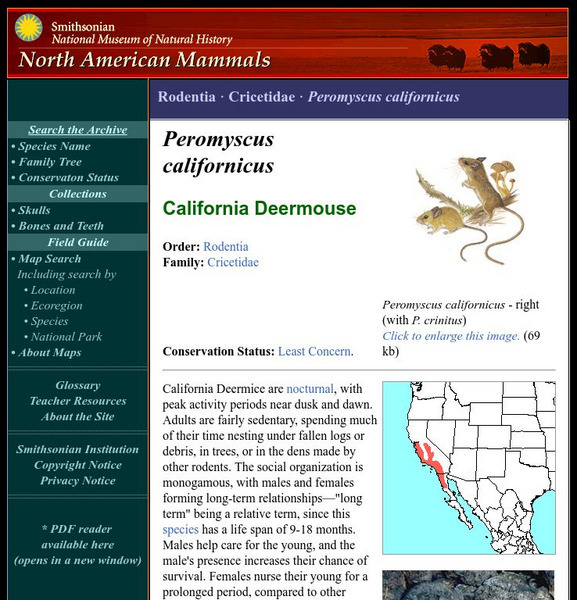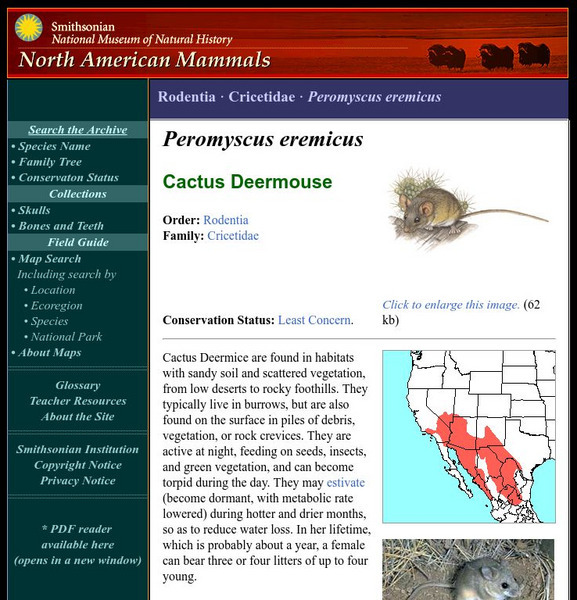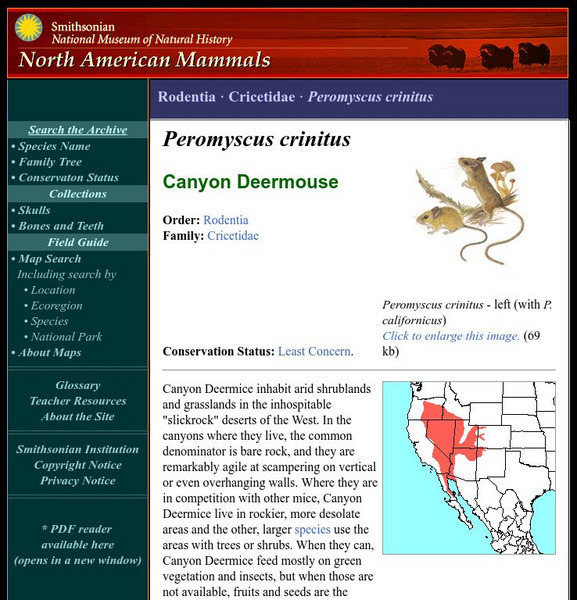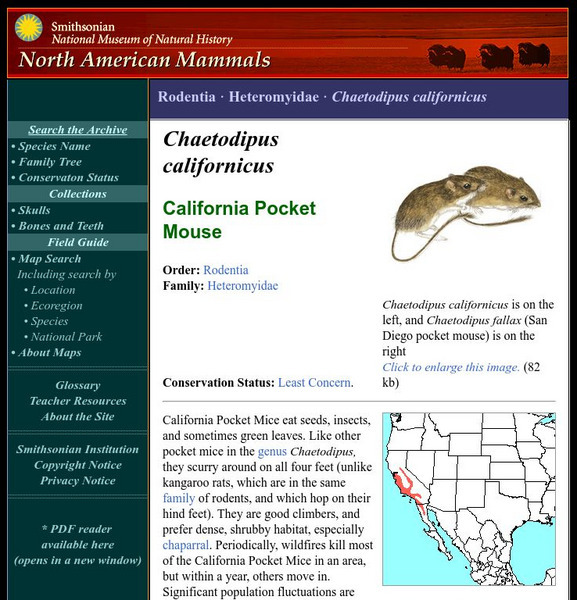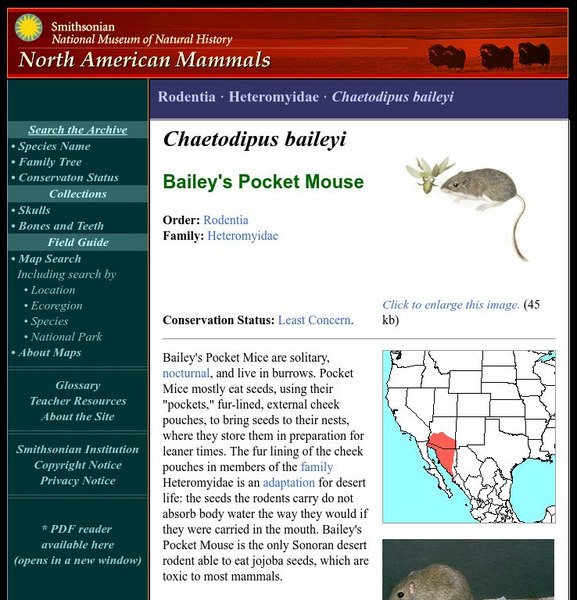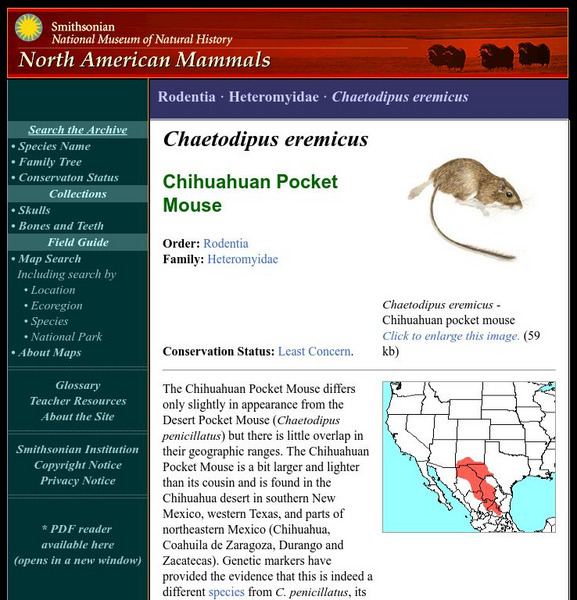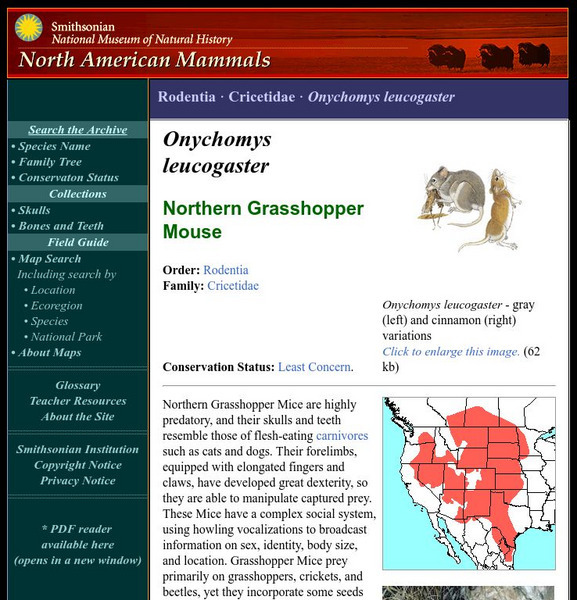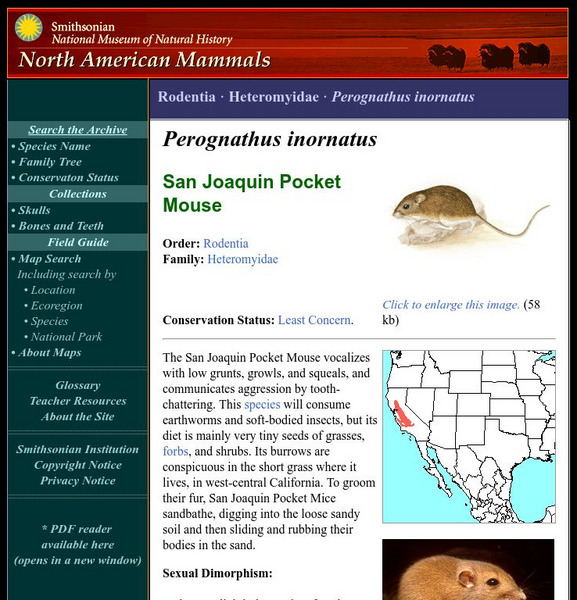Smithsonian Institution
National Museum of Natural History: American Mammals: Arizona Pocket Mouse
Like other heteromyid rodents, Arizona Pocket Mice are solitary creatures. They spend the day in underground burrows, emerging only at night. Learn more about the Perognathus amplus, more commonly known as an Arizona Pocket Mouse, in...
Smithsonian Institution
National Museum of Natural History: American Mammals: Brush Deermouse
Brush Deermice occupy rocky and brushy or forested environments in which rock ledges, piles of brush, fallen trees, and boulders offer shelter and denning sites. Although they are reportedly good climbers, they only occasionally build...
Smithsonian Institution
National Museum of Natural History: American Mammals: California Deermouse
California Deermice are nocturnal, with peak activity periods near dusk and dawn. Adults are fairly sedentary, spending much of their time nesting under fallen logs or debris, in trees, or in the dens made by other rodents. Learn more...
Smithsonian Institution
National Museum of Natural History: American Mammals: Cactus Deermouse
Cactus Deermice are found in habitats with sandy soil and scattered vegetation, from low deserts to rocky foothills. They typically live in burrows but are also found on the surface in piles of debris, vegetation, or rock crevices. Learn...
Smithsonian Institution
National Museum of Natural History: American Mammals: Canyon Deermouse
Canyon Deermice inhabit arid shrublands and grasslands in the inhospitable "slickrock" deserts of the West. In the canyons where they live, the common denominator is bare rock, and they are remarkably agile at scampering on vertical or...
Smithsonian Institution
National Museum of Natural History: American Mammals: Cotton Deermouse
A medium-sized rodent with large ears and eyes, the Cotton Deermouse is dark golden-brown above with white underparts and feet. It is very similar to the white-footed Mouse, with which it breeds in captivity. Learn more about the...
Smithsonian Institution
National Museum of Natural History: American Mammals: California Pocket Mouse
California Pocket Mice eat seeds, insects, and sometimes green leaves. Like other pocket mice in the genus Chaetodipus, they scurry around on all four feet (unlike kangaroo rats, which are in the same family of rodents, and which hop on...
Smithsonian Institution
National Museum of Natural History: American Mammals: Bailey's Pocket Mouse
Bailey's Pocket Mice are solitary, nocturnal, and live in burrows. Pocket Mice mostly eat seeds, using their "pockets," fur-lined, external cheek pouches, to bring seeds to their nests, where they store them in preparation for leaner...
Smithsonian Institution
National Museum of Natural History: American Mammals: Chihuahuan Pocket Mouse
The Chihuahuan Pocket Mouse differs only slightly in appearance from the Desert Pocket Mouse (Chaetodipus penicillatus) but there is little overlap in their geographic ranges. The Chihuahuan Pocket Mouse is a bit larger and lighter than...
Smithsonian Institution
National Museum of Natural History: American Mammals: Northern Pygmy Mouse
Northern Pygmy Mice are the smallest rodents in North America. They live in a variety of habitats where there is dense ground cover and eat grass seeds and leaves, prickly pear cactus fruit and stems, mesquite beans, and granjeno berries...
Smithsonian Institution
National Museum of Natural History: American Mammals: Pale Kangaroo Mouse
Most Pale Kangaroo Mice live in high, cold desert in Nevada; there is also a small population in eastern California. They look like small kangaroo rats, and like them, can hop on their large hind feet. Learn more about the Microdipodops...
Smithsonian Institution
National Museum of Natural History: American Mammals: Woodland Jumping Mouse
Woodland Jumping Mice can make spectacular leaps of up to 4 m. They have large feet constructed from long foot and toe bones, and very long ankles, all of which help give them leverage when they push off. Learn more about the Napaeozapus...
Smithsonian Institution
National Museum of Natural History: American Mammals: Mearn's Grasshopper Mouse
Grasshopper Mice are adapted to a predatory lifestyle. Their molar teeth have high-cusped shearing surfaces for puncturing and slicing, and their biting strength is increased through enlarged muscle attachments on the lower jaw and...
Smithsonian Institution
National Museum of Natural History: American Mammals: Southern Grasshopper Mouse
Southern Grasshopper Mice are also known as scorpion Mice: they are able to kill (and then eat) scorpions, by first immobilizing the venomous tail and then biting the head. They also prey on beetles that secrete defensive chemicals from...
Smithsonian Institution
National Museum of Natural History: American Mammals: Northern Grasshopper Mouse
Northern Grasshopper Mice are highly predatory, and their skulls and teeth resemble those of flesh-eating carnivores such as cats and dogs. Their forelimbs, equipped with elongated fingers and claws, have developed great dexterity, so...
Smithsonian Institution
National Museum of Natural History: American Mammals: San Joaquin Pocket Mouse
The San Joaquin Pocket Mouse vocalizes with low grunts, growls, and squeals, and communicates aggression by tooth-chattering. This species will consume earthworms and soft-bodied insects, but its diet is mainly very tiny seeds of...
Smithsonian Institution
National Museum of Natural History: American Mammals: Silky Pocket Mouse
The smallest Perognathus species of all, the Silky Pocket Mouse is among the smallest rodents in North America. These Mice are most active on cool, humid nights, typically foraging for fallen seeds by sifting sand with their tiny...
Smithsonian Institution
National Museum of Natural History: American Mammals: White Eared Pocket Mouse
One subspecies of the White-eared Pocket Mouse may be extinct, and the other is extremely rare, consisting of isolated, relict populations near the western Mojave Desert in California. White-eared Pocket Mice are nocturnal and probably...
Smithsonian Institution
National Museum of Natural History: American Mammals: Plains Pocket Mouse
The color of the Plains Pocket Mouse varies with soil color. The black volcanic sands near Flagstaff, Arizona harbor mice with nearly black fur, and mice with nearly white fur match the white gypsum dunes of New Mexico. Learn more about...
Smithsonian Institution
National Museum of Natural History: American Mammals: Olive Backed Pocket Mouse
The striking olive dorsum of the Olive-backed Pocket Mouse is set off by a yellowish stripe on the side and a white underside. This is the only species of pocket mouse east of the Rocky Mountains whose range extends well into Canada....
Smithsonian Institution
National Museum of Natural History: American Mammals: Merriam's Pocket Mouse
Merriam's Pocket Mice are found in short-grass prairie, desert scrub, and open, arid brushland. They are most common where the vegetation is dense enough to provide them with seeds and some protection from predators, but not so dense...
Smithsonian Institution
National Museum of Natural History: American Mammals: Texas Mouse
Texas Mice need rocky environments. Where these occur, they are found in cedar glade, juniper-grass, and oak-juniper forests. Learn more about the Peromyscus attwateri, more commonly known as a Texas Mouse, in this easy-to-read species...
Smithsonian Institution
National Museum of Natural History: American Mammals: White Ankled Mouse
The White-ankled Mouse is common in rocky areas in both dry and humid regions on the Central Plateau of Mexico and in west and central Texas, southern New Mexico, and Oklahoma. It clearly prefers rocky situations, whether it lives in...
Smithsonian Institution
National Museum of Natural History: American Mammals: Northern Rock Deermouse
Northern Rock Deermice live in rocky outcrops and among boulders in pinyon-juniper-oak woodlands in the foothills of mountains from Colorado and New Mexico south to Texas and northern Mexico. Populations of the Mice are separated from...




